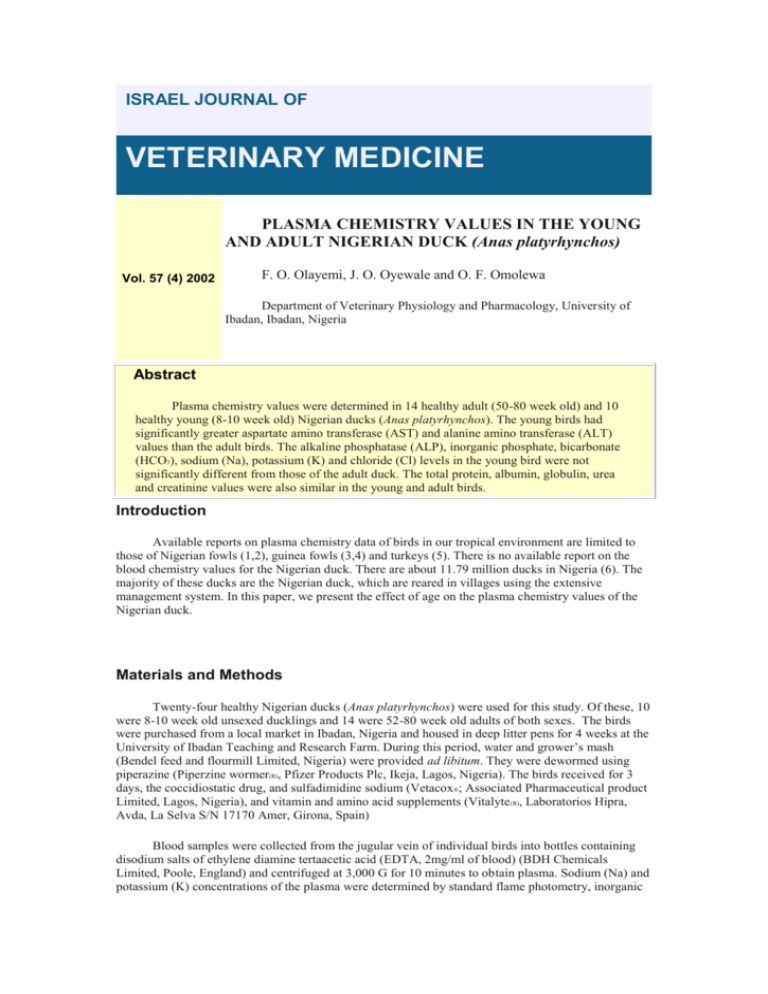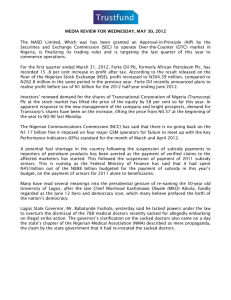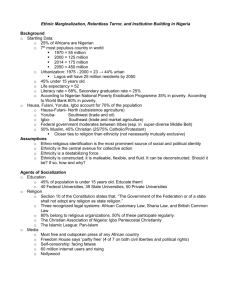plasma chemistry values in the young and adult nigerian duck
advertisement

ISRAEL JOURNAL OF VETERINARY MEDICINE PLASMA CHEMISTRY VALUES IN THE YOUNG AND ADULT NIGERIAN DUCK (Anas platyrhynchos) Vol. 57 (4) 2002 F. O. Olayemi, J. O. Oyewale and O. F. Omolewa Department of Veterinary Physiology and Pharmacology, University of Ibadan, Ibadan, Nigeria Abstract Plasma chemistry values were determined in 14 healthy adult (50-80 week old) and 10 healthy young (8-10 week old) Nigerian ducks (Anas platyrhynchos). The young birds had significantly greater aspartate amino transferase (AST) and alanine amino transferase (ALT) values than the adult birds. The alkaline phosphatase (ALP), inorganic phosphate, bicarbonate (HCO3), sodium (Na), potassium (K) and chloride (Cl) levels in the young bird were not significantly different from those of the adult duck. The total protein, albumin, globulin, urea and creatinine values were also similar in the young and adult birds. Introduction Available reports on plasma chemistry data of birds in our tropical environment are limited to those of Nigerian fowls (1,2), guinea fowls (3,4) and turkeys (5). There is no available report on the blood chemistry values for the Nigerian duck. There are about 11.79 million ducks in Nigeria (6). The majority of these ducks are the Nigerian duck, which are reared in villages using the extensive management system. In this paper, we present the effect of age on the plasma chemistry values of the Nigerian duck. Materials and Methods Twenty-four healthy Nigerian ducks (Anas platyrhynchos) were used for this study. Of these, 10 were 8-10 week old unsexed ducklings and 14 were 52-80 week old adults of both sexes. The birds were purchased from a local market in Ibadan, Nigeria and housed in deep litter pens for 4 weeks at the University of Ibadan Teaching and Research Farm. During this period, water and grower’s mash (Bendel feed and flourmill Limited, Nigeria) were provided ad libitum. They were dewormed using piperazine (Piperzine wormer(R), Pfizer Products Plc, Ikeja, Lagos, Nigeria). The birds received for 3 days, the coccidiostatic drug, and sulfadimidine sodium (Vetacox®; Associated Pharmaceutical product Limited, Lagos, Nigeria), and vitamin and amino acid supplements (Vitalyte (R), Laboratorios Hipra, Avda, La Selva S/N 17170 Amer, Girona, Spain) Blood samples were collected from the jugular vein of individual birds into bottles containing disodium salts of ethylene diamine tertaacetic acid (EDTA, 2mg/ml of blood) (BDH Chemicals Limited, Poole, England) and centrifuged at 3,000 G for 10 minutes to obtain plasma. Sodium (Na) and potassium (K) concentrations of the plasma were determined by standard flame photometry, inorganic phosphate by the method of Gomori (7), chloride by the method of Schales and Schales (8), and bicarbonate and calcium according to Toro and Ackermann (9). Total protein was determined by the biuret method (10) and albumin by the method of Doumas (11). Globulin was obtained by subtracting the albumin from the total protein. Urea and creatinine were determined according to Harrison (12). The levels of aspartate aminotransferase and alanine aminotransferase were determined colorimetrically according to Mohun and Cook (13). Alkaline phosphatase was determined according to the method described by King and Armstrong (14). Statistical tests were carried out by the Student’s t-test. Results Table I compares the plasma electrolyte and enzyme levels in young and adult Nigerian duck. The young birds had significantly higher AST (P<0.01) and ALT (P<0.001) than the adult Nigerian duck. Plasma Na, K, C1, HCO3, Ca, inorganic phosphate and ALP were however similar in the young and adult Nigeria ducks. Table 1: Plasma electrolyte and enzyme levels (mean±SD) in young and adult Nigerian Duck Parameters Young (n=10) Adult (n=14) Na (mmol/L) 145.90±8.45 149.40±4.47 K (mmolL) 5.83±1.99 6.00±1.55 Cl (mmol/l) 105.90±3.81 108.43±1.98 HCO3 (mmol/l) 23.50±3.17 24.07±1.73 Ca (mg/dl) 8.63±0.21 8.56±0.21 Inorganic Phosphate (mg/dl) 4.95±0.62 4.41±0.29 ALP (i.u/l) 74.40±11.68 81.00±12.48 AST (i.u/l) 37.00±4.29 29.93±5.66* ALT (i.u/l) 30.10±4.65 20.71±6.76** Value significantly different from young duck at *P<0.01 **P<0.001 Table II shows the effect of age on the plasma protein and metabolite levels in the Nigerian duck. There were no significant differences between the young and adults in the total protein, albumin, globulin, albumin/globulin ratio, urea and creatinine values. Table II: Plasma protein and metabolite levels (mean±SD) in young and adult Nigerian ducks. Parameter Young (n=10) Adult(n=14) Total protein (g/dl) 5.95±0.36 5.91±0.29 Albumin (g/dl) 2.85±0.17 2.81±0.21 Globulin (g/dl) 3.10±0.22 3.09±0.11 Albumin/globulin Ratio 0.92±0.05 0.91±0.06 Urea (mg/dl) 27.10±13.25 29.50±12.92 Creatinine (mg/dl) 1.20±0.47 1.24±0.46 Discussion In the present study there were no significant differences in the plasma Na, K, Cl, HCO 3, Ca and inorganic phosphate levels (Table I). However, Work (15) reported that adult Hawaiian dark-rumped petrels (Pterodoma phaeopygia) and wedge-tailed shearwaters (Puffinus pacificus) had lower Ca and inorganic phosphate values than the young. He also observed that adult frigatebirds (Fregata minor) had greater Ca and inorganic phosphate values than the young birds. However, in geese it was reported that the plasma Ca value remained unchanged and Cl value increased while inorganic phosphate levels decreased with age (16). Young Nigerian ducks had significantly higher plasma AST and ALT levels than adult birds (Table 1). The mean AST in the adult Nigerian ducks (29.93 i.u/l) was lower, while the mean ALT (20.71 i.u/l) was higher than in adult guinea fowls (AST=155-171.67 i.u/l) ALT=9.17-12.50 i.u/l) (4) and white England turkeys (AST=772.50 i.u/l. ALT=10.70 i.u/l) in the same environment (5). There were no significant differences between the young and adult Nigerian ducks in total protein, albumin, globulin, albumin/globulin ratio, urea and creatinine values (Table II). Work (15) reported increases in total protein, albumin and globulin values with age in pelecaniform birds. Wolf (17) found that in brown pelicans (Pelecanus occidentalis) globulins and total protein values increased with age but albumin decreased. In the domestic fowls (18) and Japanese quail (19), the total protein value decreased with age. The mean Ca, inorganic phosphate and Cl values in adult Nigerian duck (Table 1) are lower than the values (Ca=104mg/dl; inorganic phosphate=6.2mg/dl; Cl=370mmol/l) reported by Soliman (20) in adult Egyptian ducks. Also, the Na and Cl values in Nigerian duck are lower, but the K value is higher than those found by Balasch (21) in Galliformes (Na=153.90-168.17mmol/l; Cl=109.50122.50mmol/l; K=2.25-3.58mmol/l). In comparison to the electrolyte values in adult Nigerian fowls, reported by Oyewale (2), the adult Nigerian duck in our present study had higher Na (149.40 vs 133.60 mmol/l) K(6.00 vs 3.88mmol/l) and HCO3 values (24.07 vs. 20.59 mmol/l), but lower Ca value (8.56 vs 9.89 mg/dl) and not too different Cl (108.48 vs 106.4 mmol/l) and inorganic phosphate values (4.41 vs 4.04 mmol/l). The total protein (5.91 g/dl), albumin (2.81gldl) and globulin values (3.09 g/dl) in adult Nigerian ducks (Table II) were higher than values reported by Makinde and Fatunmbi (5) in adult White England turkeys (total protein=3.93g/dl; albumin 1.55g/dl; globulin=2.36 g/dl) reared in the same tropical Nigerian environment Oyewale (2) reported a higher globulin value (3.43g/dl) and lower albumin (1.55gldl) and total protein values (4.95gldl) in Nigerian fowl than those obtained here in Nigerian ducks. The urea (7.20mg/dl) and creatinine values (0.59mg/dl) found in adult Egyptian duck by Soliman (20) are lower than values observed in adult Nigerian ducks (Table II). The high urea value as well as the high total plasma protein value probably reflects the adequate state of nutrition of the Nigerian ducks used in the present study. LINKS TO OTHER ARTICLES IN THIS ISSUE References 1. Olowookorun, M. O., Ayeni, J. S and Aire, T. A.: Plasma glucose and alkaline phosphate levels in guinea fowls (Numida meleagris) and Nigerian domestic fowls (Gallus domestics). Zbl. Vet. Med. A 27: 578-582, 1980. 2. Oyewale, J. O Olowookorun, M. O., Abatan , M. O and Fajimi, J. L.: Serum electrocyte and protein levels in guinea fowls (Numida meleagris) and Nigerian fowl (Gallus domesticus). Beitr?ge trop. Landwirtsch. Veterinarmed 26: 81-85, 1988. 3. Olowookunrun, M. O, Makinde, M. O and Aire T. A.: Plasma transaminase activity in Nigerian fowl (Gallus domesticus). And guinea fowl (Numida meleagris). .IRCS Medical Sciences, Biochemistry, Experimental Animals 7, 53. 4. Ayeni, J. S .: The biology and utilization of the helmet guinea fowl (Numida meleagris galeata, pallas) in Nigeria. Ph.D. Thesis. University of Ibadan, 1980. 5. Makinde, M. O and Fatunmbi, O. O.: Some haemotalogical and biochemical values of turkey in Ibadan. Bull. Anim Hlth. Prod. Afr. 33: 245-248, 1985. 6. Arowolo, R. O. A.: Protecting our Livestock Resources. 1995/96 Inaugural lecture, University Printery, U.I Ventures Ltd., Ibadan, Nigeria, p. 5, 1999. 7. Gomori,.G.: A modification of the calorimetric determination of phosphorus for use with the photoelectric colorimeter. J.Lab. Clin Med. 27: 955-976, 1942. 8. Schales, O. and Schales, S. S.: A simple and accurate method for the determination of chloride in biological fluids. J. Biol. Chem. 140: 879-884, 1941. 9. Toro, G. and Ackermann, P.: Practical Clinical Chemistry. 1 st ed. Little Brown and Company Boston. pp 237-238, 1975. 10. Reinhold, J. G.: Manual determination of serum total protein albumin and globulin fractions by Buiret method. In: M. Reiner (Ed): Standard Method of Clinical Chemistry; Academic Press, New York, p. 88, 1953. 11. Doumas, B. T., Watson, W. and Biggs, H. G.: Albumin standards and the measurement of serum albumin with bromocresol green. Clin Chim. Acta. 31: 87-96, 1971. 12. Harrison, G. A.: Clinical Methods in Clinical Medicine, 3rd ed. Churchhill, London; 1947 13. Mohun, A, E. and Cook, P.: Simple method for measuring serum levles of the glutamateoxaloacetate and glutamic pyruvic transaminase in the routine laboratory. J. Clin. Path. 10: 374-399, 1957. 14. King, E. J and Armstrong, A. R.: A convenient method for determining serum and bile phosphates activity. Can. Med. Assoc. J. 31: 376-381, 1934. 15. Work, T. M.: Weights, haematology and serum chemistry of seven species of free ranging tropical pelagic seabirds. J. Wildl. Dis. 32: 643-657, 1996. 16. Hunt, J. R; Hunsaker, W. G. and Aitken, J.R.: Physiology of the growing and adult goose.II .Some biochemical constituents of blood. Br. Poult. Sci. 5: 257-262 1964. 17. Wolf, S. H., Schreiber, R.W., Kahana, L. and Torres, J. J.: Seasonal, sexual and age related variation in the blood composition of the brown pelican (Pelecanus occidentalis). Comp. Biochem. Physiol. 82A: 837-846, 1985. 18. Brandt, L. W., Clegg, R. E. and Andrews, A. C.: The effect of age and degree of maturity on the serum proteins on the chicken. J. Biol. Chem. 191: 105-111, 1951. 19. Nirmalan, G. P. and Robinson, G. A.: Haematology of the Japanese quail (Coturnix coturnix japonica). Br. Poult. Sci. 12: 475-481 1971 20. Soliman, M. K., El Amrousi, S. and Ahmed, A. A. S.: Cytological and biochemical studies on the blood of normal and spirochaete- infected ducks. Zbl. Vet. Med. B 13: 82-86, 1966. 21. Balasch, J., Palacois; L., Musquera, S., Palomeque ,J., Jimenez, M. and Alemany, Comparative haematological values of several galliformes. Poult. Sci. 52: 1531-1534, 1973. M.:








